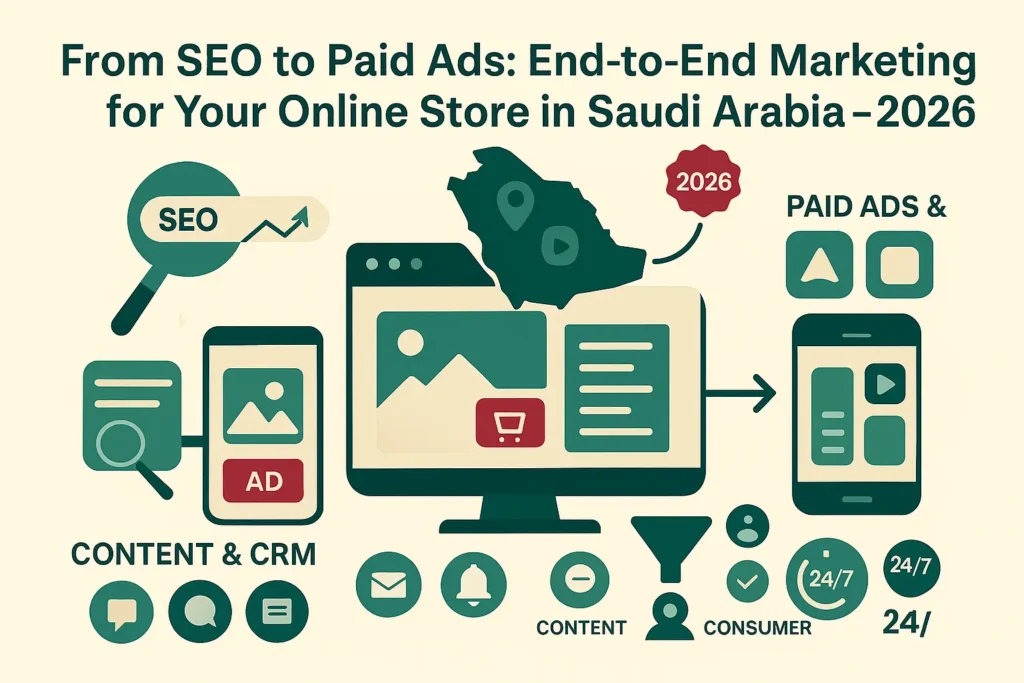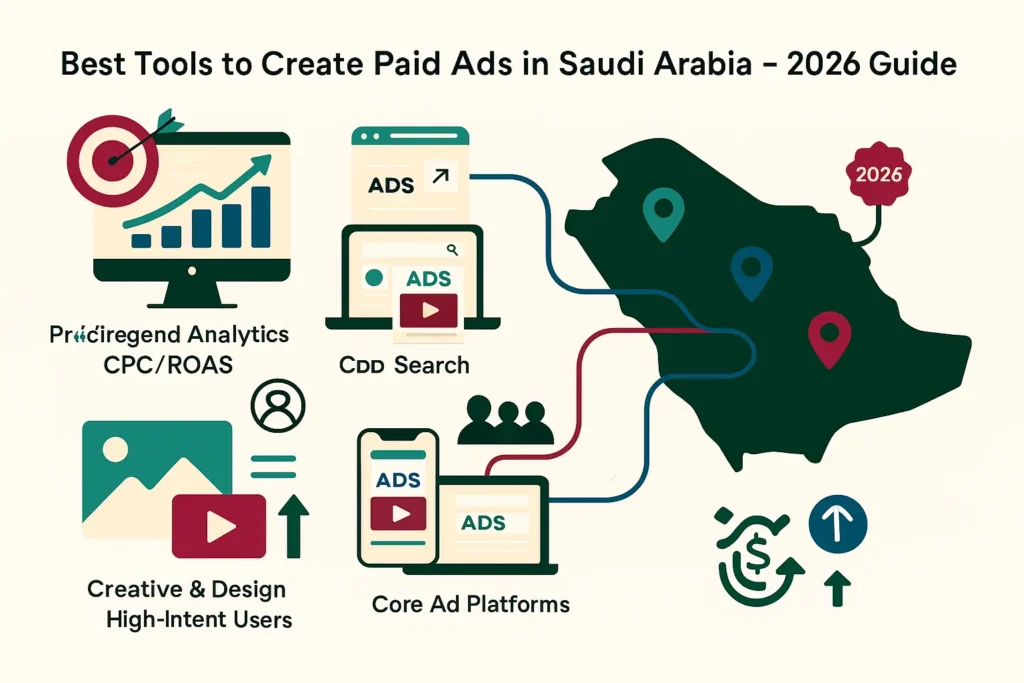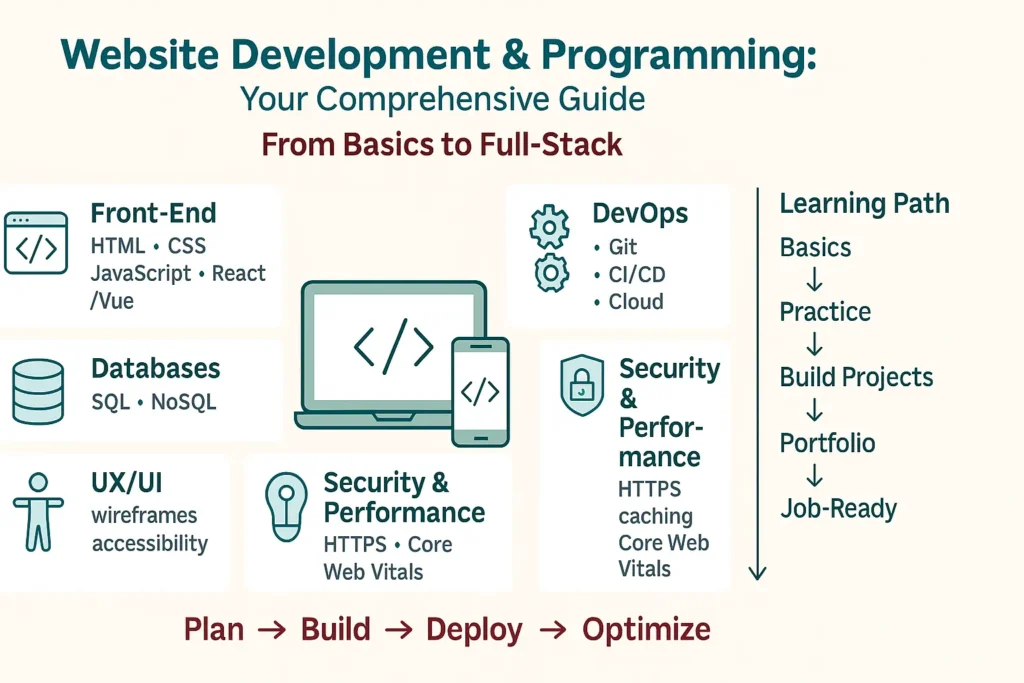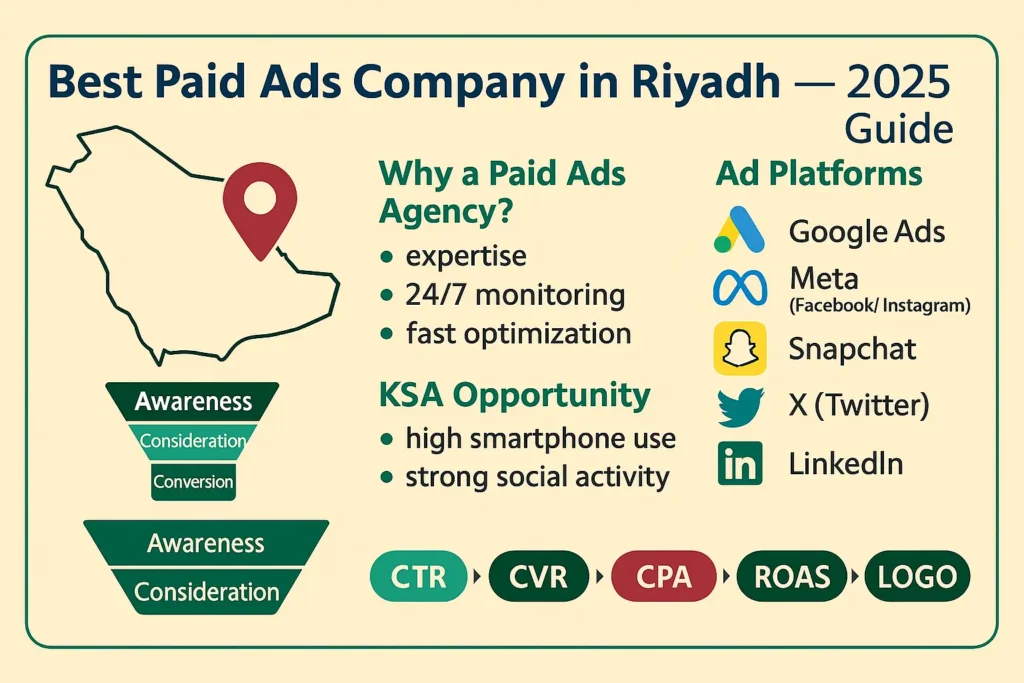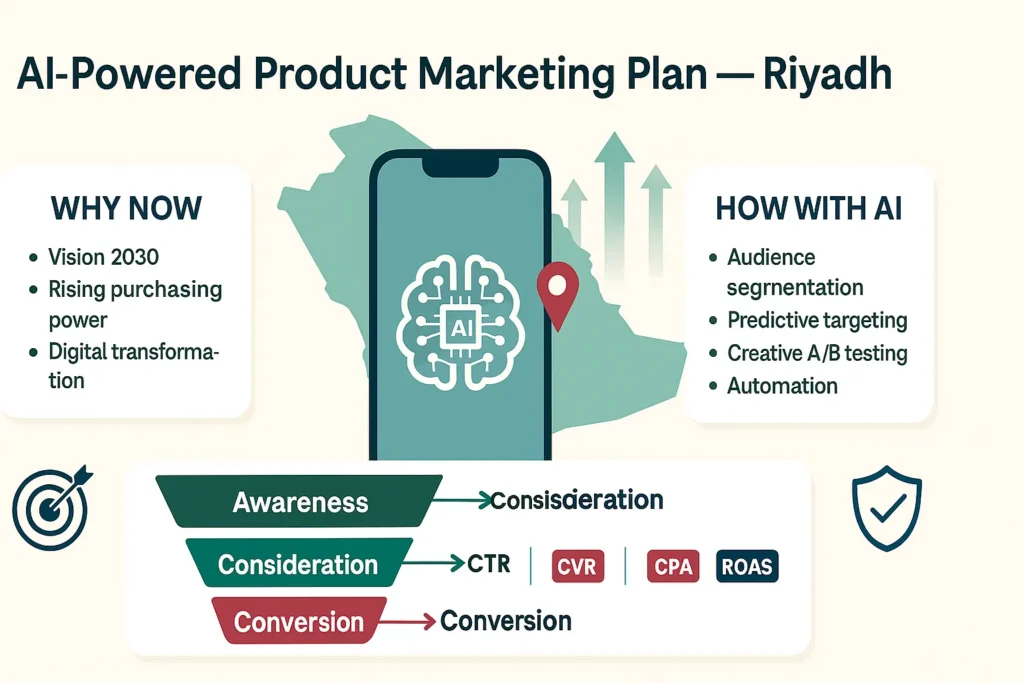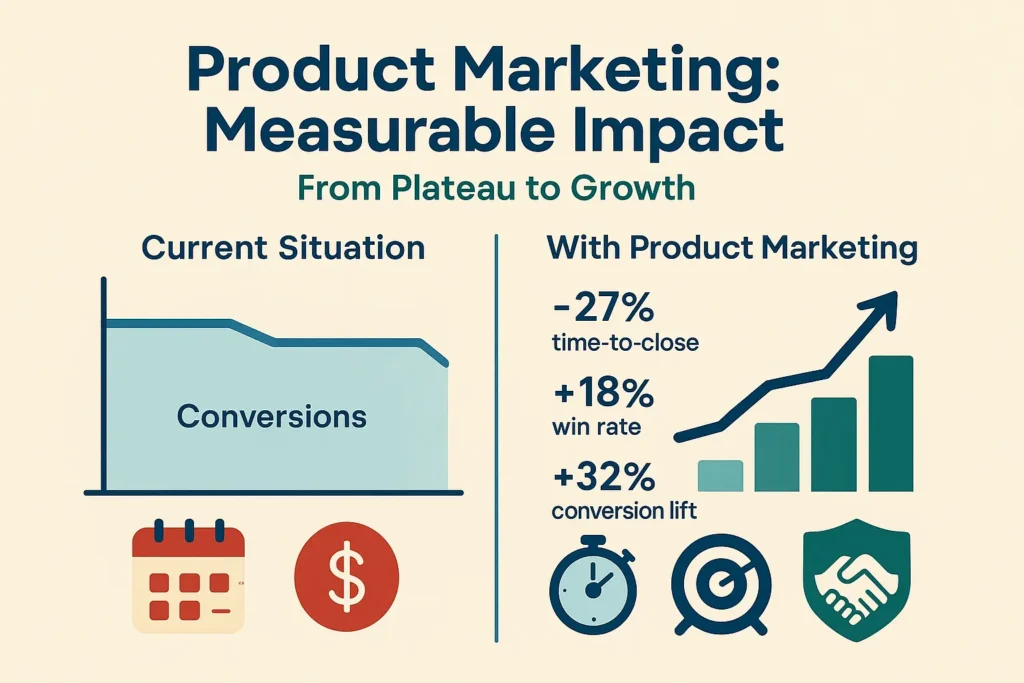
Is Product Marketing Worth Hiring? Here Are the Numbers and Benefits
Benefits of Product Marketing: Measurable Impact
You’ve built a solid product. Your engineering team is shipping features regularly. Your sales team is working hard, but deals are taking longer to close than expected. And your marketing campaigns are generating leads, but conversion rates have plateaued. Sound familiar?
This is the exact moment when most growing companies start asking themselves: “Do we need to hire a product marketer?” The question isn’t really about whether you can afford to make this hire—it’s whether you can afford not to.
The misconception that product marketing is a “nice-to-have” luxury has cost countless companies millions in lost revenue. While your competitors struggle with the same challenges, companies that invest strategically in product marketing are quietly pulling ahead, shortening their sales cycles, increasing win rates, and building stronger market positions.
What you’re about to discover are the concrete numbers, measurable benefits, and real-world data that will help you understand exactly what this investment can deliver for your business.
The Current State of Product Marketing: By the Numbers
The landscape of product marketing has undergone significant evolution over the past five years. According to recent industry research, 78% of companies with over $10 million in annual revenue now have dedicated product marketing functions, compared to just 45% in 2019.
Here’s what the investment typically looks like: Product marketing professionals command salaries ranging from $85,000 for entry-level positions to $180,000+ for senior roles, with total compensation packages often reaching $220,000 when including bonuses and equity. When you factor in benefits, tools, and operational costs, you’re looking at a total first-year investment of $120,000 to $280,000, depending on seniority level.
But here’s where the numbers get interesting. Companies that implement product marketing functions report a 23% average reduction in sales cycle length within the first six months. More compelling still, research from SiriusDecisions shows that organizations with mature product marketing operations achieve 19% faster revenue growth compared to those without.
The buyer behavior data tells an even more compelling story. Today’s B2B buyers consume an average of 13 pieces of content before making a purchasing decision, and 67% of the buyer’s journey now happens without any sales interaction. This shift means your product positioning and messaging—core product marketing responsibilities—have never been more critical to revenue generation.
The Quantifiable ROI of Product Marketing Investment
The financial impact of hiring a product marketer becomes clear when you examine the key performance indicators that matter most to your bottom line.
Sales Cycle Acceleration: Companies report an average 23% reduction in time-to-close after implementing structured product marketing. If your current average deal takes 6 months to close, you’re looking at shaving off nearly 6 weeks per deal. For a company closing $2M in new business annually, this acceleration alone can drive an additional $300,000+ in revenue within the first year.
Win Rate Improvements: This is where the numbers get really compelling. Organizations with dedicated product marketing see win rates improve by 15-40%, with the higher end of that range typically achieved by companies in competitive markets. If you’re currently winning 25% of qualified opportunities and a product marketer helps you reach 32%, that’s a 28% improvement in closed business.
Revenue Per Customer: Effective positioning and messaging directly impact deal sizes. Companies report an average 18% increase in average contract value when product marketing optimizes how solutions are packaged and presented to buyers. This isn’t about raising prices—it’s about helping customers understand and purchase the full value your product provides.
Customer Acquisition Cost Reduction: Perhaps most importantly, targeted messaging reduces wasted marketing spend. Companies typically see CAC decrease by 12-25% as product marketing helps focus resources on the highest-converting customer segments and channels.
The compound effect of these improvements creates substantial ROI. A conservative calculation shows that a $150,000 annual investment in product marketing typically generates $450,000 to $750,000 in additional revenue impact within 12 months.
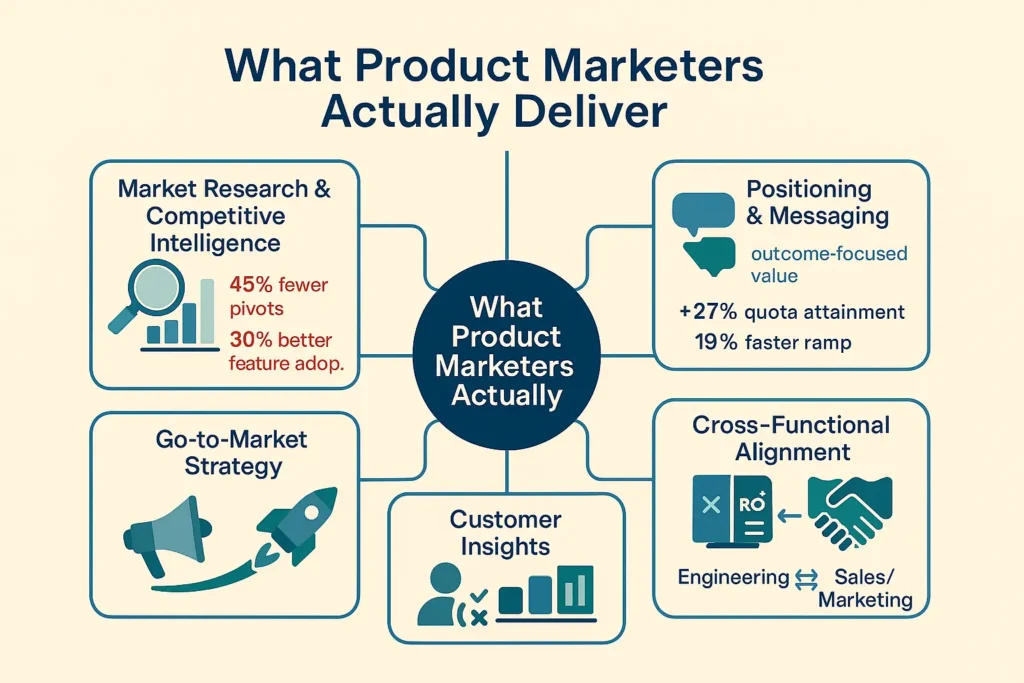
What Product Marketers Actually Deliver (And Why It Matters)
Understanding the ROI is important, but knowing exactly what you’re getting for your investment is crucial for setting proper expectations and measuring success.
Market Research and Competitive Intelligence: Your product marketer becomes your organization’s eyes and ears in the market. They conduct systematic research to understand customer needs, track competitive movements, and identify market opportunities. This intelligence directly informs product development priorities and helps avoid costly missteps. Companies with strong competitive intelligence programs report 45% fewer product pivots and 30% better feature adoption rates.
Positioning and Messaging That Converts: This is where the magic happens. Your product marketer transforms technical features into compelling business value propositions. They develop messaging frameworks that your entire go-to-market team can use consistently. The result? Sales conversations that focus on outcomes rather than features, marketing campaigns that resonate with buyer pain points, and customer success interactions that reinforce value.
Sales Enablement Materials That Accelerate Deals:
Product marketers create the tools your sales team needs to be effective: battle cards, competitive comparisons, ROI calculators, demo scripts, and objection-handling guides. And Sales teams with comprehensive enablement materials report 27% higher quota attainment and 19% faster ramp times for new hires.
Go-to-Market Strategies That Maximize Launch Impact: Whether you’re launching a new product, entering a new market, or releasing major features, your product marketer owns the strategy that determines success or failure. They coordinate across teams, manage timelines, and ensure launches generate maximum market impact.
Customer Insights That Drive Product Strategy: Product marketers are your customer advocates within the organization. They conduct win-loss interviews, analyze usage data, and maintain ongoing dialogue with your market. This feedback loop ensures your product roadmap stays aligned with actual customer needs rather than internal assumptions.
Cross-Functional Alignment: Perhaps most valuable of all, product marketers serve as translators between technical teams and customer-facing teams. They ensure everyone understands not just what you’re building, but why it matters to customers and how to talk about it effectively.
The Hidden Costs of NOT Having Product Marketing
While the benefits of hiring a product marketer are compelling, the costs of not having one are often devastating—and largely invisible until it’s too late.
Revenue Leakage from Poor Positioning: Without clear, consistent positioning, your sales team is essentially improvising value propositions in every deal. This leads to longer sales cycles, lower win rates, and smaller deal sizes. Companies often don’t realize they’re leaving 15-30% of potential revenue on the table simply because prospects don’t understand their differentiated value.
Wasted Marketing Spend: Marketing teams without product marketing support often create campaigns based on assumptions rather than customer insights. This results in content that doesn’t resonate, campaigns targeting the wrong audiences, and messaging that focuses on features instead of business outcomes. The average company wastes 25-40% of its marketing budget on ineffective initiatives.
Extended Sales Cycles:
When your sales team doesn’t have proper enablement materials and consistent messaging, deals drag on indefinitely. Prospects get confused by mixed messages, objections go unaddressed, and opportunities stall in the pipeline. Each additional month in your sales cycle typically costs you 8-12% of the deal value due to the time value of money and increased competition risk.
Product-Market Fit Challenges: Without systematic market feedback and customer research, product teams build features based on internal opinions rather than market demand. This leads to low adoption rates, customer churn, and expensive product pivots. Companies with weak product marketing functions report 40% lower feature adoption rates and 60% more frequent roadmap changes.
Competitive Disadvantages: In competitive markets, positioning is everything. Companies without strong product marketing often find themselves competing primarily on price because they can’t effectively articulate their differentiated value. This erodes margins and commoditizes their offerings.
The cumulative cost of these issues typically exceeds $500,000 annually for companies with $5-10M in revenue, and scales dramatically as organizations grow.
When and How to Make Your First Product Marketing Hire
Timing your first product marketing hire correctly is crucial for maximizing impact and ensuring success. Several key indicators suggest your company is ready for this investment.
Revenue and Team Size Signals: Most successful product marketing hires happen when companies reach $3-8M in annual recurring revenue and have 15-30 employees. At this stage, you have enough complexity to warrant specialized focus but aren’t so large that the role becomes unwieldy.
Market Dynamics: If you’re operating in a competitive market with multiple viable alternatives, product marketing becomes essential earlier. Companies in crowded spaces often need product marketing by the $2M ARR mark to maintain a competitive advantage.
Sales Team Feedback: When your sales team starts asking for better positioning materials, competitive intelligence, or help with objection handling, these are clear signals that product marketing would drive immediate value.
Hire vs. Contract Decision: Many companies successfully start with part-time contract help before committing to a full-time hire. An experienced product marketing consultant working 15-20 hours per week can deliver substantial value while you evaluate the full-time investment. This approach typically costs $5,000-8,000 per month and provides a lower-risk path to proving value.
Essential Qualifications: Look for candidates with a blend of analytical and creative skills. The best product marketers combine strategic thinking with tactical execution ability. Industry experience matters, but cross-functional collaboration skills and customer empathy are often more predictive of success.
Organizational Structure: Product marketing should report to either the VP of Marketing or the VP of Product, depending on your company’s go-to-market model. The key is ensuring they influence both product development and revenue generation functions.
Budget Planning: Beyond salary, budget for tools (typically $3,000-5,000 annually), research and analysis resources, and content creation support. Plan for a 6-9 month ramp period before seeing full productivity.
Measuring Success: KPIs That Matter
Establishing clear success metrics upfront ensures your product marketing investment delivers measurable business value.
Leading Indicators: Track these metrics within 30-60 days of hiring. Sales team confidence scores in product positioning typically improve by 25-40% in the first quarter. Content engagement rates—time spent on battlecards, messaging documents, and positioning materials—should increase by 50%+ as teams adopt new resources.
Revenue-Based Metrics: These prove long-term ROI. Win rates should improve within 90 days, with meaningful improvement (5-15% increase) typically visible within six months. Average deal sizes often increase 10-20% within the first year as positioning improves. Sales cycle length should decrease by 15-25% within 6-9 months.
Operational Efficiency Improvements: Product launch success rates improve dramatically with proper product marketing. Companies report 40-60% better launch performance measured by adoption rates, customer feedback, and revenue achievement versus targets.
Customer Metrics: Net Promoter Scores typically improve as positioning becomes more aligned with actual customer value. Feature adoption rates increase 20-35% when product marketing properly educates the market about new capabilities.
Market Position Indicators: Brand awareness in target segments, competitive win rates, and analyst recognition all improve with effective product marketing. These metrics often take 12-18 months to show significant movement, but are crucial for long-term competitive advantage.
The key is establishing baseline measurements before your hire starts, then tracking progress monthly. Companies that actively measure product marketing impact see 30% better performance than those that don’t.
Keep reading and uncover secrets that can change the way you work. Secrets of Successful E-Commerce Marketing: What Your Competitors Are Doing That You Don’t Know?
Real-World Success Stories: Companies That Made the Investment
Series A Startup Doubles Conversion Rates: A $4M ARR cybersecurity company was struggling with a 2% website conversion rate despite strong inbound traffic. Six months after hiring their first product marketer, conversion rates increased to 4.3%. The product marketer redesigned their value proposition, created industry-specific messaging, and developed targeted content for different buyer personas. The improved positioning generated an additional $1.2M in pipeline within nine months, delivering 8x ROI on the hire.
B2B SaaS Reduces Customer Acquisition Cost by 30%: A marketing automation company with $12M ARR was spending $4,800 to acquire each new customer. Their product marketer conducted extensive customer research and discovered they were targeting too broad an audience. By narrowing focus to specific verticals and creating targeted campaigns, CAC dropped to $3,360 within eight months. The improved targeting also increased average contract values by 22%, creating a compound positive impact on unit economics.
Enterprise Company Revitalizes Stagnant Product Lines: A $50M software company saw one of its core products losing market share to newer competitors. The product marketing hire conducted a comprehensive competitive analysis, interviewed churned customers, and repositioned the product around unique capabilities the market had overlooked. Within 12 months, the product line grew by 35% and regained competitive differentiation. The repositioning effort generated $4.2M in additional revenue.
Each of these companies followed similar playbooks: they hired experienced product marketers, gave them access to customers and data, and empowered them to influence both product strategy and go-to-market execution. The common thread was leadership commitment to acting on product marketing recommendations, even when they challenged existing assumptions.
Keep reading and uncover secrets that can change the way you work. How to Benefit from Digital Marketing and SEO
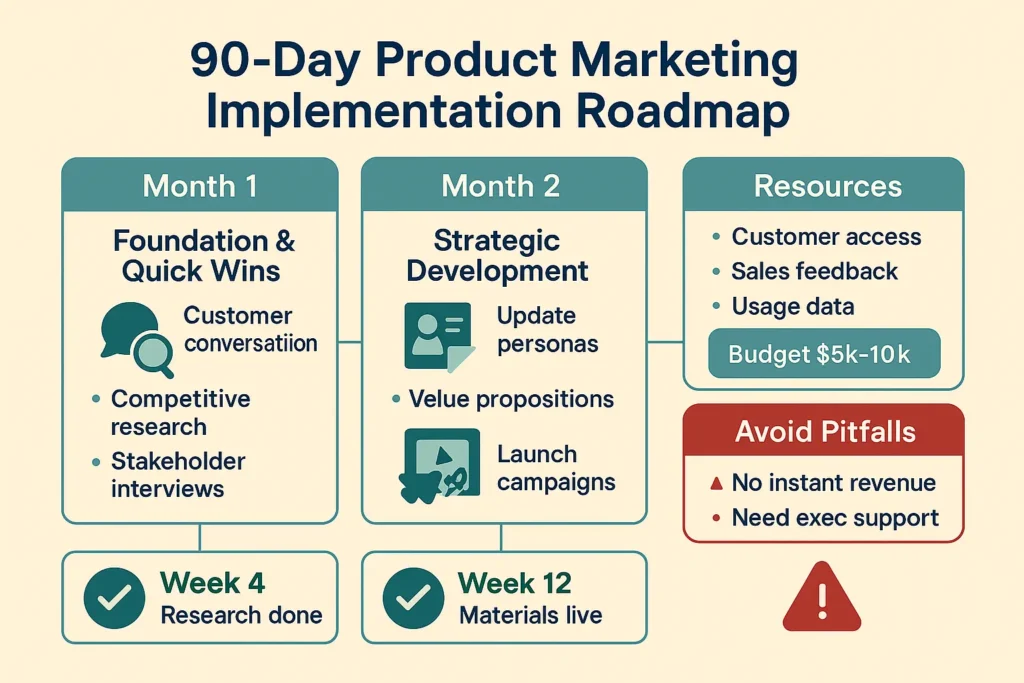
Your 90-Day Product Marketing Implementation Roadmap
Month 1: Foundation and Quick Wins: Your new product marketer should spend their first 30 days immersed in customer conversations, competitive research, and internal stakeholder interviews. Quick wins include updating outdated sales materials, creating basic competitive positioning, and establishing regular feedback loops with sales and customer success teams. By day 30, you should see improved sales team confidence and more consistent messaging in customer conversations.
Month 2: Strategic Development: The second month focuses on developing comprehensive positioning and messaging frameworks. This includes creating detailed buyer personas, mapping the customer journey, and developing core value propositions. Your product marketer should also establish processes for ongoing market research and competitive monitoring. Success metrics include completed messaging documentation and initial campaign strategy development.
Month 3: Implementation and Optimization: The final month of the initial phase involves full-scale implementation of new positioning across all customer touchpoints. This includes updating website copy, creating sales enablement materials, and launching initial marketing campaigns with improved messaging. Teams should be using new materials consistently, and you should see early indicators of improved performance.
Key Milestones: Week 4: Customer research completed and insights documented. Week 8: Positioning and messaging frameworks finalized and approved. Week 12: New materials deployed and being used by customer-facing teams.
Resource Requirements: Ensure your product marketer has direct access to customers, sales team feedback, and product usage data. Budget $5,000-10,000 for research tools, survey platforms, and initial content creation during this period.
Avoiding Common Pitfalls: Don’t expect immediate revenue impact—positioning changes take time to influence buyer behavior. Ensure your product marketer has enough senior stakeholder support to implement recommendations that might challenge existing approaches.
Keep reading and uncover secrets that can change the way you work. Get More Leads with Our Proven Content Marketing Strategies
Making the Business Case: Your Investment Blueprint
ROI Calculation Framework: Use this simple model to calculate potential return. Take your current annual revenue and multiply it by 0.15 (conservative estimate of revenue improvement from product marketing). Subtract your total annual investment (salary + benefits + tools). Most companies see 3-5x ROI within 18 months.
Example Calculation: $8M current revenue × 15% improvement = $1.2M additional revenue potential. Investment of $180K total compensation yields 6.7x ROI in year one.
Presentation Template for Executive Buy-In: Structure your business case around three key points: the cost of delayed decisions (every month without product marketing costs X% of potential revenue), competitive necessity (your competitors are already investing in this function), and scalability (product marketing capabilities become more valuable as you grow).
Risk Mitigation Strategies: Address skeptical stakeholders by starting with contract work or part-time engagement. Establish clear 90-day milestones with measurable outcomes. Create accountability through regular stakeholder reviews and performance dashboards.
Timeline Expectations: Most companies see initial improvements within 60-90 days, meaningful revenue impact within 6 months, and full ROI realization within 12-18 months. Set expectations accordingly and focus on leading indicators during the early months.
Competitive Necessity Argument: In today’s market, product marketing isn’t optional—it’s table stakes. Companies that invest early gain sustainable advantages that become harder for competitors to overcome. The question isn’t whether to hire a product marketer, but whether you can afford to let competitors gain this advantage first.
Turn your goals into real achievements with our tailored services – request the service now.
Frequently Asked Questions
What’s the difference between product marketing and regular marketing?
Product marketing focuses specifically on positioning and selling products, while traditional marketing builds brand awareness and generates demand. Product marketers dive deep into specific customer segments and craft messaging that drives purchasing decisions, whereas traditional marketers cast a wider net to build overall brand recognition and attract prospects to your company.
How much should I budget for a product marketing hire?
Total compensation ranges from $85K-$180K depending on experience level and company size, with additional budget needed for tools and programs. Plan for $120K-$280K in total first-year costs, including benefits, tools, and operational expenses.
Can I start with a contractor instead of a full-time hire?
Yes, many companies successfully begin with a 10-20 hours per week contract work to prove value before making a full-time commitment. This typically costs $5,000-8,000 monthly and provides a lower-risk path to demonstrating ROI.
What background should I look for in a product marketing candidate?
Look for a mix of analytical skills, customer empathy, cross-functional collaboration experience, and industry knowledge relevant to your market. The best candidates combine strategic thinking with tactical execution ability and have experience working with both product and sales teams.
How long before I see results from a product marketing hire?
Quick wins typically appear within 30-60 days through improved sales confidence and better messaging consistency. Meaningful revenue impact usually becomes measurable within 6 months, with full ROI typically realized within 12-18 months of the hire.
Your Investment Blueprint: The Path Forward
The data is clear: companies that invest in product marketing see measurable improvements in win rates, sales cycle length, and average deal sizes. The organizations thriving in today’s competitive landscape aren’t necessarily those with the best products—they’re the ones that can most effectively communicate their value to the right customers at the right time.
Your decision isn’t really whether product marketing delivers value. The numbers prove it does. Your decision is whether you’re ready to make the investment that will accelerate your growth and create sustainable competitive advantages.
Consider this: while you’re evaluating whether to hire a product marketer, your competitors may already be implementing the strategies that will help them win deals you should be closing. In fast-moving markets, the cost of delayed decisions often exceeds the cost of making imperfect ones quickly.
The framework for success is straightforward: hire experienced talent, give them access to customers and data, empower them to influence both product and go-to-market decisions, and measure their impact rigorously. Companies that follow this approach consistently see 3-5x ROI within 18 months.
The question isn’t whether you can afford to hire a product marketer. The question is whether you can afford not to. Your next competitor certainly hopes you’ll keep waiting.




